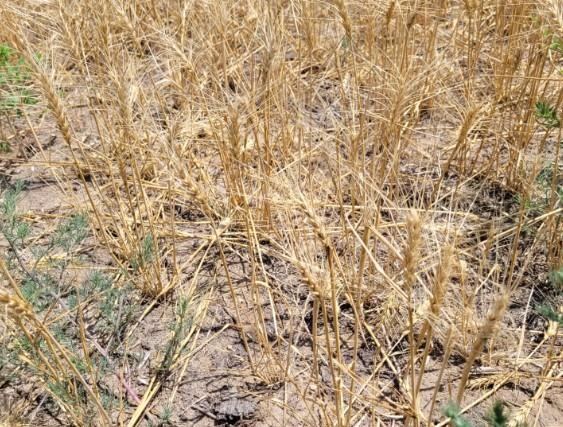By Rae Solomon
One glance around the Northrup dining room will clue you in to the family business. A bouquet of dried wheat stems sits at the center of the table. Even the china dinnerware set on display in the built-in hutch is embellished with a gold-plated wheat pattern. It’s a family heirloom that goes back generations.
Nate Northrup grew up in this dining room. He is now the 4th generation of his family growing winter wheat on about 3,000 dry acres in New Raymer, Colorado, a small town in far-eastern Weld County. It’s just him and his father working the land with a rotation of wheat and other crops like millet and milo, in between fallow years.
Dryland farming has never been easy. But in recent years, Northrup has been battling a new challenge that would have baffled earlier generations: the wheat stem sawfly. It’s a pest that infests wheat stems at the base, flattening fields — usually just before the harvest.
Northrup described a slow progression of sawflies infiltrating his wheat fields, starting in 2010.
“It used to be just a few swaths around the edges,“ he said. “And then, the next year following, it would just be entire fields, just laying on the ground.”
Last fall, Colorado farmers planted more than 2 million acres of winter wheat for the 2022 harvest. But persistent drought is hurting Colorado’s crop, and the sawfly infestation only worsens things.

Collapsed wheat stalks
The mature bugs emerge in the spring and lay their eggs in young wheat stems. As the wheat grows, so do the sawfly larvae, eating their way down to the bottom of the plant. Just as the wheat ripens and becomes ready for harvest, the larvae ripen and get ready to hibernate. It makes itself an overwintering chamber just above the root and, in the process, takes a final big bite at the base of the wheat stem, weakening it beyond repair. The first wind or sprinkling of rain topples the weakened stalks flat on the ground.
Dr. Erika Peirce is a postdoctoral researcher at Colorado State University who specializes in integrated pest management of the wheat stem sawfly, which, she is quick to point out, is not actually a fly.
“Contrary to the name. It's actually a wasp,” she explained. She says sawfly may be a new pest, but the bug is not new to Colorado. “It was initially discovered in non-cultivated grasses - the grasses on the side of the road — in 1874 in Colorado. It only became a pest of winter wheat in Colorado in 2010.”
Peirce says the sawfly’s transformation from benign native insect to threatening pest happened because of a change in its lifecycle. Initially, adult sawfly timed their emergence to align with the growth of the non-cultivated grasses that were its native host. She explained that winter wheat develops earlier in the season than those native grasses.
“The sawfly, in order to use winter wheat, has to mature and emerge about 3 to 4 weeks earlier than they normally would for their native hosts,” she said.
And eventually, they started doing just that.
“The sawfly over the years slowly started emerging earlier and earlier,” Peirce explained. Eventually, the bugs synced up with winter wheat. Peirce is still studying why this shift took place. “We're looking into climate and landscape variables that might impact sawfly,” she said.
Whatever the science behind this shift in sawfly behavior, Nate Northrup says it’s devastating to his fields and not just for the crop that gets flattened — a field leveled by sawfly also devastates the next year’s harvest.
Click here to see more...